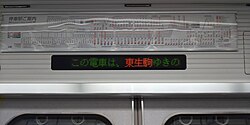| Kintetsu 5820 series | |
|---|---|
 A 5820 series on the Osaka Line A 5820 series on the Osaka Line | |
| Manufacturer | Kinki Sharyo |
| Family name | Series 21 |
| Constructed | 2000–2003 |
| Entered service | 2000 |
| Number built | 42 vehicles (7 sets) |
| Number in service | 42 vehicles (7 sets) |
| Formation | 6 cars per trainset |
| Fleet numbers | DH21 – DH25, DF51 – DF52 |
| Operators | |
| Depots | Saidaiji, Takayasu |
| Lines served | |
| Specifications | |
| Car body construction | Aluminium |
| Car length | 20,720 mm (68 ft 0 in) |
| Width | 2,800 mm (9 ft 2 in) |
| Height | 4,150 mm (13 ft 7 in) |
| Doors | 4 pairs per side |
| Maximum speed | 110 km/h (70 mph) |
| Traction system | Variable frequency (IGBT) |
| Power output | 185 kW per motor |
| Acceleration | 2.5 km/(h⋅s) (1.6 mph/s) 3.0 km/(h⋅s) (1.9 mph/s) |
| Deceleration | 4.0 km/(h⋅s) (2.5 mph/s) |
| Electric system(s) | 1,500 V DC overhead line |
| Current collector(s) | Pantograph |
| Bogies | KD-311 |
| Braking system(s) | Electronically controlled pneumatic brakes |
| Safety system(s) | Kintetsu ATS (old/new) Hanshin ATS |
| Track gauge | 1,435 mm (4 ft 8+1⁄2 in) |
The Kintetsu 5820 series (近鉄5820系) is an electric multiple unit (EMU) commuter train type operated by the private railway operator Kintetsu Railway since 2000.
Operations
The 5820 series sets mainly operate on Nara Line services, including through-running to and from Hanshin Electric Railway lines. In addition, two of these sets are set aside for operations on the Osaka Line.
Formations
As of 1 April 2012, the fleet consists of seven six-car sets, with five sets based at Saidaiji Depot for Nara Line services, and two sets based at Takayasu Depot for use on Osaka Line services.
Saidaiji Depot sets
As of 1 April 2012, there are five six-car sets, based at Saidaiji Depot, formed as follows, with three motored (M) cars and three non-powered trailer (T) cars, and the 5720 car at the Namba/Kyoto end.
| Designation | Tc | M | T | M | Tc | |
|---|---|---|---|---|---|---|
| Numbering | Ku 5720 | Mo 5820 | Mo 5620 | Sa 5520 | Mo 5420 | Ku 5320 |
The motored cars are each fitted with one cross-arm or single-arm pantograph.
Takayasu Depot sets
The two six-car Osaka Line sets are formed as follows, with three motored (M) cars and three non-powered trailer (T) cars, and the 5350 car at the Osaka end.
| Designation | Tc | M | T | M | Tc | |
|---|---|---|---|---|---|---|
| Numbering | Ku 5350 | Mo 5450 | Sa 5550 | Mo 5650 | Mo 5850 | Ku 5750 |
The motored cars are each fitted with one cross-arm or single-arm pantograph.
Interior
Passenger accommodation consists of longitudinal bench seating on the ends of each car. The sections between the doors can be rotated into either a 2+2 perpendicular configuration or a six-seat longitudinal configuration.
A western-style toilet is installed on the Osaka Line sets.
 2+2 perpendicular configuration
2+2 perpendicular configuration Longitudinal configuration
Longitudinal configuration Wheelchair space at the end of the car
Wheelchair space at the end of the car Passenger info display
Passenger info display
See also
Kansai
- Kintetsu 6820 series, a narrow-gauge 2-car derivative of the 9020 series
- Kintetsu 9020 series, similar two-car sets
- Kintetsu 9820 series, similar six-car sets with permanent longitudinal seating throughout
Kanto
- Tobu 50090 series and 70090 series, Tobu Railway commuter EMU types that also features rotating longitudinal/transverse seating
- Keio 5000 series, a Keio commuter EMU type that also features rotating longitudinal/transverse seating
- Keikyu 2100 series, a Keikyu commuter EMU type that also features transverse seating
- Keikyu 1000 series, another Keikyu commuter EMU type also features rotating transverse seating (batch 20 only)
References
- ^ 私鉄車両年鑑2012 [Japan Private Railways Annual 2012]. Tokyo, Japan: Ikaros Publications Ltd. February 2012. p. 32. ISBN 978-4-86320-549-9.
- ^ 私鉄車両編成表 2012 [Private Railway Rolling Stock Formations - 2012]. Japan: JRR. July 2012. pp. 123–127. ISBN 978-4-330-29911-2.
External links
| Commuter/suburban |
|  | ||||||
|---|---|---|---|---|---|---|---|---|
| Limited express |
| |||||||
| Excursion |
| |||||||